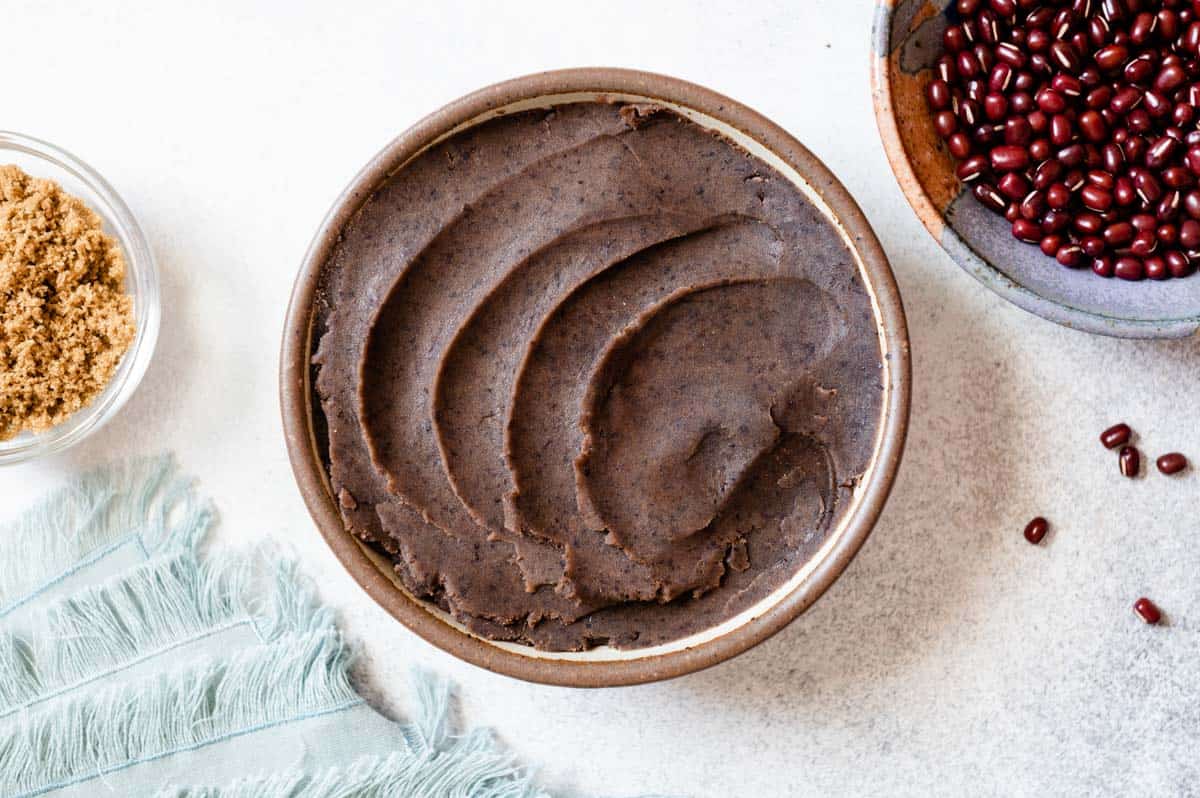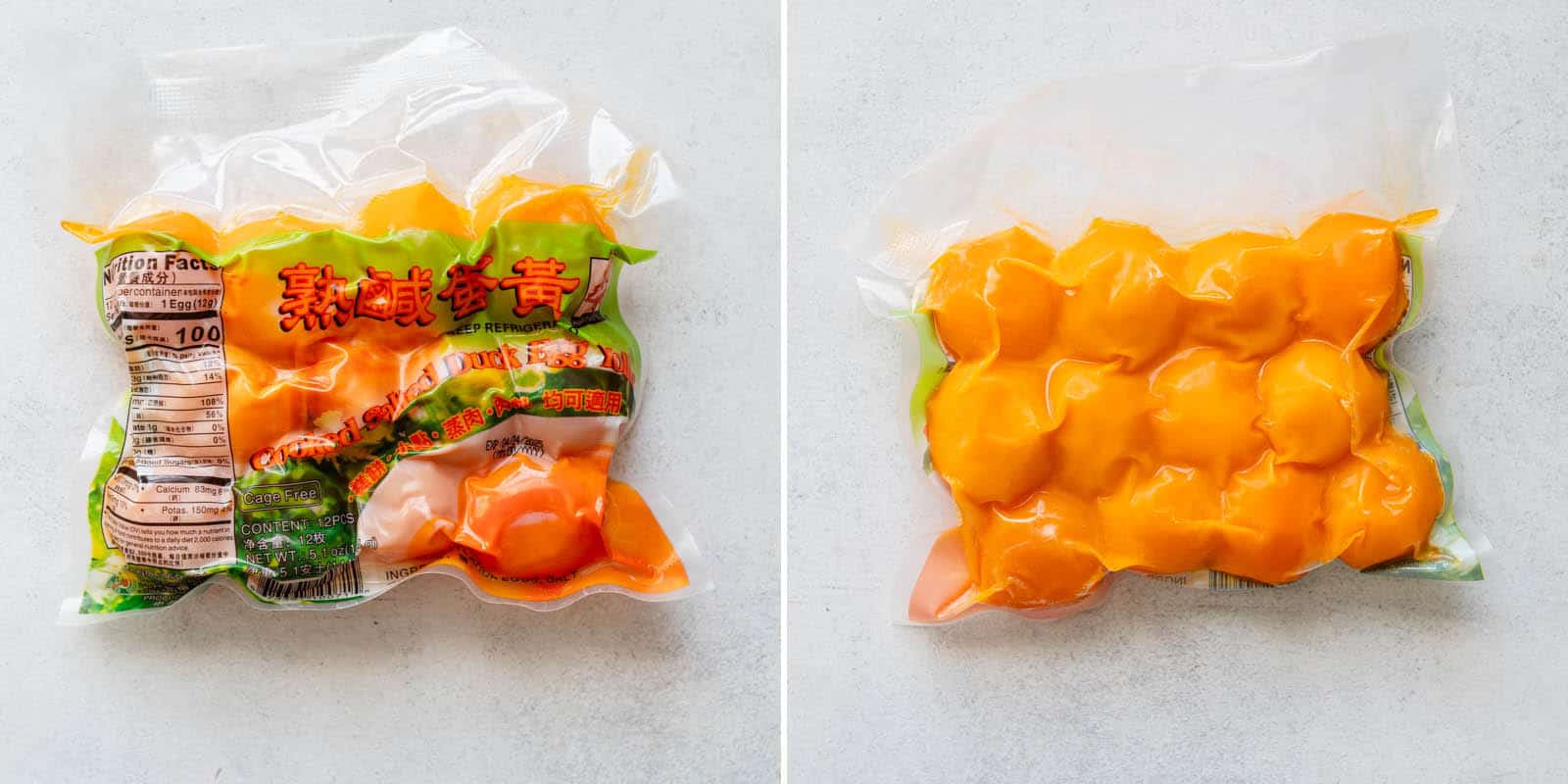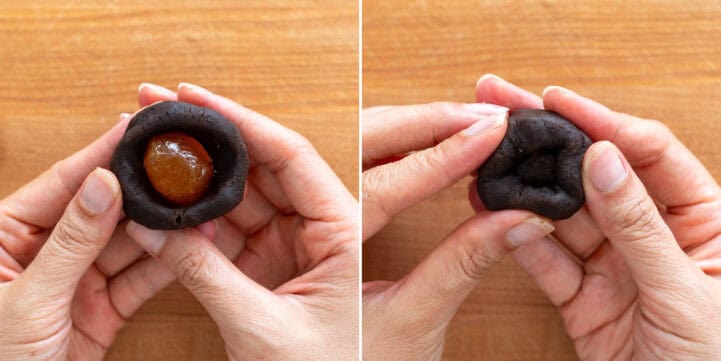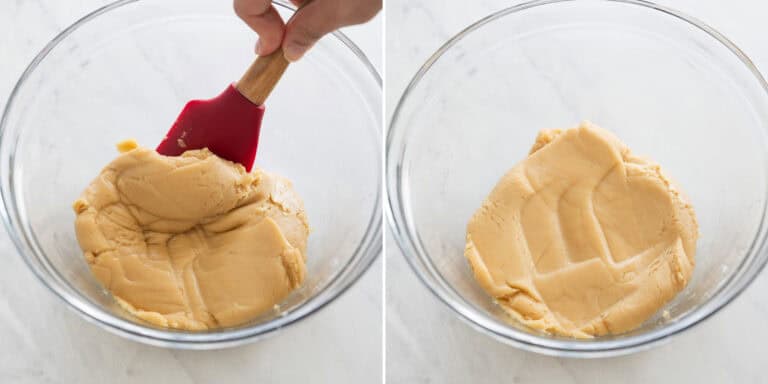Historically, China was an agrarian society, so many of the holidays in Chinese culture revolve around the celebration of harvest. In this case, 中秋節 began as a celebration of the bounty of the mid-autumn harvest. People also believed that on this day of the year, the full moon was at its largest and brightest. Thus, it was the perfect time for families to gather and celebrate harmony and togetherness.
CANTONESE-STYLE MOONCAKES
Today, when we think about the Mid-Autumn Festival now, mooncakes immediately come to mind. There are many varieties of mooncakes, but traditional Cantonese-style mooncakes (廣式月餅) are what I grew up eating. Traditional Cantonese-style mooncakes are golden brown cakes with a thin and soft outer skin that wraps a sweet filling (often red bean paste or lotus seed paste) and possibly one or two salted egg yolks. They also generally have intricate designs or patterns on the top of the cakes, many of which contain the logo or name of the bakery that made the mooncakes. Mooncakes are labor intensive to make, which is why they can carry a high price tag. Mama Lin shared a mooncake recipe with me several years ago, but I had been avoiding making them on my own. I knew it would take a long time before I was able to make reasonably nice looking mooncakes, and I figured my mom would make mooncakes for the family. This year, I finally decided to put my big-girl pants on and just face this challenge head on. After baking many, many batches of mooncakes over the past two months, I am proud to say that I can make delicious red bean paste mooncakes that I prefer over store-bought ones! This mooncake recipe is a long one, as there is a lot of information and cooking tips that I want to share. Get ready as we dig deep into the mooncake-making process.
COOKING NOTES FOR MOONCAKE RECIPE
MAKING THE MOONCAKE SKIN
While you only need 4 ingredients to make the mooncake skin, there are 2 that you’ll need to get in specialty stores or online: golden syrup and kansui. Golden Syrup is a type of inverted sugar syrup (called 轉化糖漿 in Chinese) that’s a popular ingredient in a lot of British desserts. It’s a syrup made from sugar, water, and an acid (such as lemon juice) to prevent the syrup from crystallizing. Golden syrup is a key ingredient that gives Cantonese-style mooncakes its distinct taste, texture, and golden color. Kansui, 鹼水/枧水 (jian shui in Mandarin and gansui in Cantonese), is known as “lye water” or “alkaline water” in English. Usually sold in bottles, kansui is a mixture of potassium carbonate and sodium bicarbonate. Because kansui is an alkaline solution, it raises the pH in a food item.
RED BEAN PASTE FILLING
I modified my red bean paste recipe to make the filling for these mooncakes. First, I bumped up the amount of sugar from 1/2 cup to 3/4 cup (I thought the mooncakes tasted bland with less sugar). If you want to consume less sugar, stick to the original half cup amount. I also added an additional tablespoon of walnut oil to ensure that the paste stays moist even after the baking process. To avoid a ridiculously long recipe below, I omitted the steps on making the red bean paste below. Please refer to my red bean paste recipe for directions and ingredient amounts.
MOONCAKE MOLDS
There are many types of molds you can use to make mooncakes. First, there’s traditional wooden ones that look like a paddle with a cavity in the center (see photo above, right). At the bottom of the cavity is an intricate pattern that has been carved into the wood. Another, more popular, type of mold are plastic ones with a large handle sticking up from the center (see photo above, left). I like using this style of mooncake mold because they often come as sets with plates that you can change to give mooncakes different designs.
SALTED EGG YOLK
In many traditional Cantonese-style mooncakes, you’ll find one or two round salted egg yolks in the center of the mooncake. The yolks symbolize the full moon of the Mid-Autumn Festival. Growing up, I absolutely loved eating the salted yolk, but I started to like them less and less and I’ve gotten older. The mooncake recipe below outlines how to make mooncakes without the yolks. However, I’ll add directions in the notes section on how to make mooncakes with salted yolks.
BAKING MOONCAKES
In general, you usually bake the mooncakes twice. First, you bake the mooncakes for 10 minutes. Then, remove the mooncakes from the oven, brush a thin layer of egg wash over the mooncakes and bake them for another 9 to 10 minutes. When applying the egg wash, make sure to apply a very thin layer so you don’t flood the indentations of the design on the top of the mooncake. If you apply too much egg wash, the design won’t come out as clearly after the mooncakes are baked. I like to use a small natural bristle brush (not silicone) to brush the egg wash over the mooncakes. Immediately after I apply the egg wash to one mooncake, I brush the top with a second natural bristle brush to remove excess egg wash. You do not need to brush the sides of the mooncake with egg wash. To ensure even baking, I bake the mooncakes in two batches (8 mooncakes at a time).
FRESHLY BAKED MOONCAKES
Freshly baked mooncakes are solid as a rock. They also tend to have some cracks at the top and the designs don’t look as sharp. This is completely normal. In general, you should wait 2 days before eating the mooncakes (even better if you are patient enough to wait for 3 days). During these 2 days, the moisture and oil will return to the skin in a process known as 回油 in Chinese, which loosely translates to “letting the oil return.” After 2 days, the skin softens, the cracks fade away, and you can see a shiny gloss develop on the top of the mooncakes. Of course, you can eat the mooncakes the day they’re made or the next day but expect dry mooncakes.
HOW LONG DO MOONCAKES LAST?
Store the mooncakes in an airtight container for up to 5 days. You can also store the mooncakes in the fridge for up to 8 or 9 days or freeze them for several months. Let the mooncakes reach room temperature before eating again.
HOW TO SAY MID-AUTUMN FESTIVAL IN CHINESE
There are many different ways to say the Mid-Autumn Festival in Chinese. Here are some common names and their pronunciations:
中秋節 (中秋节 in simplified characters): This literally translates to the “mid-autumn festival” and is pronounced zhong chau jzeet in Cantonese and zhong qiu jie in Mandarin. This is the most commonly used name to describe the festival. 八月節 (八月节 in simplified characters): This literally translates to the “festival of the eight month” and is pronounced baht yoot jzeet in Cantonese and bot ngoot daht in Toisan. This is what the festival was commonly called in 台山 (Toisan/Taishan), a region in southern China where my family was from. I’m not sure if Mandarin-speaking communities actually use this phrase to describe the Mid-Autumn Festival. 八月十五: This literally translates to the fifteenth day of the eight month and is pronounced baht yoot sup mm in Cantonese and ba yue shi wu in Mandarin. 團員節 (团圆节 in simplified characters): This literally translates to “reunion festival” and is pronounced toon yoon jzeet in Cantonese and tuan yuan jie in Mandarin.




















